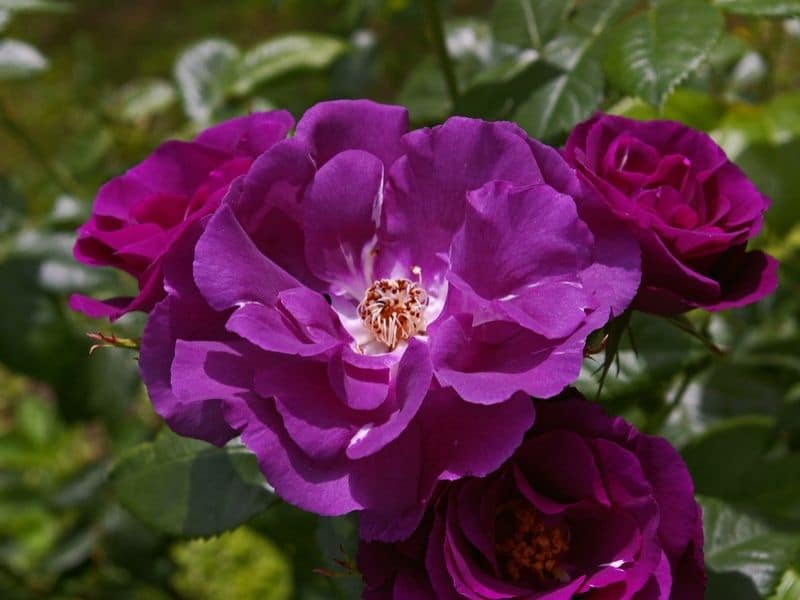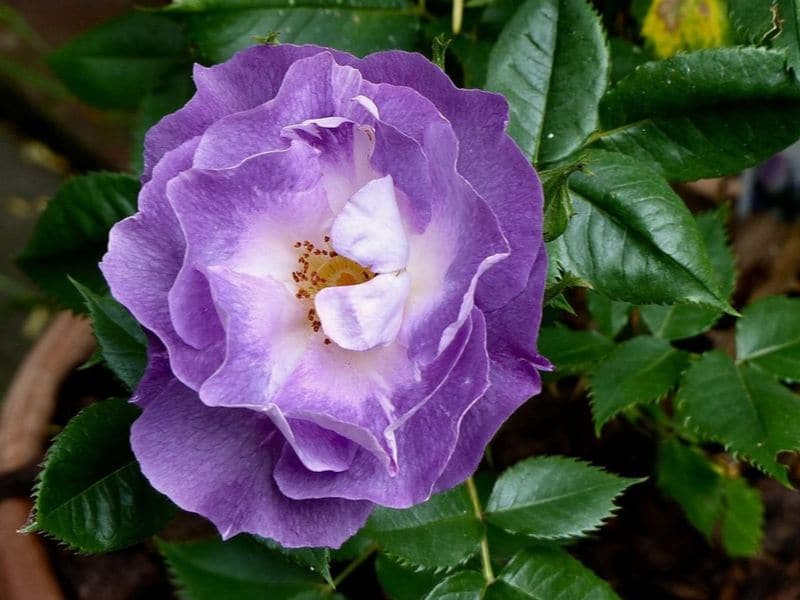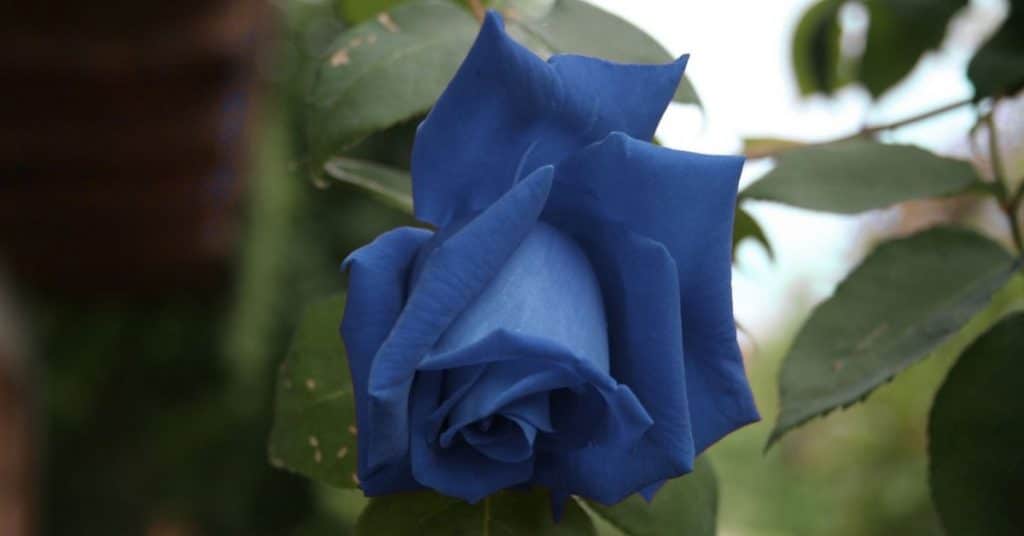Everyone admires the blue in nature, a clear blue sky, and the deep blue sea. It seems that the earth is abundant with this cool color but ironically, blue is the rarest naturally-occurring pigment. In fact, there are only a few species that possess a true blue color both in the animal and plant kingdoms.
With this challenging phenomenon, plant breeders, scientists, florists, and even amateurs embarked on a quest to discover a one of a kind blue rose. Over time, they learned that it doesn’t exist in the wild and it can’t be bred either so for many years, they could only long for this elusive rose.
“Roses are red, violets are blue” but why can’t roses be blue, too? This comprehensive guide will help you answer this question and understand the seemingly unattainable blue rose. If you love blue flowers, you’ll enjoy this article!
History and Legends
Do Blue Roses Really Exist?
The first ever record of the blue rose was by the Arabian agriculturist, Ibn al-Awam, in his agriculture handbook written in the 12th century. He talked about an azure rose in his garden but its existence was never confirmed (1).
Researchers today speculate that he could be referring to the blue Hibiscus syriacus ‘Rose of Sharon’ instead. Not much was scientifically written about the blue rose after that but the mysterious flower became the subject of many folklores.
A famous Chinese story is called the ‘Legend of the Blue Rose’ and it tells of a young princess who would only marry the man who could bring her a blue rose.
One suitor painted a white rose blue, another carved a sapphire into a shape of a rose, and another made a holographic illusion of a blue rose. Alas, the princess announced them all fake for she knew that a blue rose did not exist and that she couldn’t marry the man she forbiddenly loved, the gardener of their palace.
The next day, the gardener offered her a white rose and upon this courageous act, the princess received the flower and as she touched the petals, the flower magically turned into a blue rose. The gardener and the princess got married and lived happily.
If only it was that easy to find a blue rose. Most blue roses today are just like the fake ones in the story. Although the color is vibrant and opaque, the existing blue roses are either dyed (dip dye and dye absorption) or painted (floral spray).
But in 2004, a scientific breakthrough in genetic engineering led to the discovery of the first technically-accepted blue rose.
Genetic Modification
Unlike violets and larkspurs, roses lack delphinidin, a plant pigment responsible for the blue color in plants. This is why a natural blue rose, even through classical cross-breeding methods, has remained elusive in the world of roses (2).
However, after 14 years of experimentation through genetic engineering, a team of scientists from Suntory in Japan collaborated with Florigene in Australia and made a noise when they announced that they finally formulated the recipe to create true blue roses!
How Was the Blue Rose Created?
Scientists have identified that aside from the missing delphinium-based anthocyanin pigment in roses, there are other factors that will determine if the rose plant can produce blue petals such as the presence of co-pigments as well as the plant’s vascular pH.
After selecting the white rose plants that will serve as hosts, they harvested the delphinidin-carrying gene from blue Viola and Iris and inserted them to the hosts. The resulting rose flowers accumulated the blue pigment in the petals and thus gave rise to the stable and remarkable blue-colored blossoms (3).
In 2006, the first blue roses, named ‘Applause’ were officially introduced to the market at the World Rose Convention in Osaka, Japan and in 2011, the blue rose was then introduced to North America. Even though the beautiful flowers were mostly mauve or blue with tinges of red, they were well received by the community and the project was considered a success. The Japanese company, Suntory now aims to perfect the blue-colored rose as well as develop other flowers in the shade of blue.
Another recent study claims to have found a new way to produce blue roses. In 2018, Chinese researchers Yihua Cheng and Yan Zhang developed a simpler process of turning white roses into blue-colored ones.
Agrobacterium tumefaciens is a bacteria that is often used in plant research because of its ability to insert foreign DNA into the genetic makeup of plants. After identifying the bacterial enzymes that can turn certain constituents of rose petals to blue, the researchers injected the enzyme-containing A. tumefaciens into a white rose petal and a blue color spread from the injection site on the petal.
Unlike the Rose ‘Applause’, the color of this rose flower is absolutely blue in a lighter shade. The experiment result, however astonishing, was short-lived though. Since the enzymes were injected, the color is mottled and later fades. So the researchers are now moving forward with the goal to make the rose plant produce the enzymes itself (4).
Cultivars
The quest for the perfect genetically modified rose still continues but the research industry is definitely a couple of steps closer to creating the true blue rose. In the meantime, rose cultivars that are almost blue in color are equally adored and are more readily available.
Blue Rose ‘Applause’

The first scientifically-accepted blue rose was created through the Suntory-Florigene research efforts in 2006. The resulting flower has a refreshing scent and the color is mauve with tinges of red hence mainly marketed as a cut flower.
Rosa ‘Rhapsody in Blue’

This rose plant was hybridized by Frank Cowlishaw in 1999 which easily became a favorite because of the iridescent bluish-mauve petals and golden stamens of the fully opened flowers. It is a repeat-flowering shrub commonly used as landscape borders as it grows tall and bushy.
Rosa ‘Cardinal de Richelieu’
This rose flower has a dark purple color that almost looks blue. A gallica rose, the plant was discovered by Louis-Joseph-Ghislain Parmentier in 1847 and is now widely used by florists as cut flowers.
Rosa ‘Blue for You’

Otherwise known as ‘Pacific Dream’ or ‘Honky Tonk Blues’ this purple roses have a blush center. Hybridized by Peter J. James in 2006, the plant grows up to 1.5m and a favorite in themed gardens.
Rosa ‘Veilchenblau’
Also known as ‘Bleu Violet’ or ‘Blue Rosalie’, this rose was hybridized by Johann Christoph Schmidt in 1909. The scented mauve flowers are large and clustered and the color fades to almost blue. Other distinguishing characteristics are the emerald green leaves and the almost thornless stems.
Rosa ‘Mainzer Fastnacht’
This rose is otherwise known as ‘Blue Moon’ Rose, a hybrid tea rose characterized by the lilac-mauve color with a strong fragrance. The plant grows as a shrub reaching up to a meter in height and was discovered by Mathias Tantau in 1964 (5).
See more: How to prune roses
What Is The Meaning of Blue Roses?
It is no surprise that the universal connotation for blue roses is “the impossible or unattainable”. Because of its unlikely occurrence in nature, people have associated the blue rose with unreachable dreams and desires. It is said that when someone gives a blue rose, they are expressing their appreciation of love or beauty that they will never have.
In the language of flowers, blue rose symbolizes unique and extraordinary. It is the symbol of hope and an indication of spiritual longing being the color of the sky (6).
Blue Rose Meaning by Shade
- Light blue roses signify dreams, hopes, and aspirations. They evoke a sense of longing and anticipation.
- Dark blue roses may represent wisdom, intuition, and inner knowing. It suggests profound insights and understanding.
FAQs
What do blue roses mean in a relationship?
Blue roses, which are not naturally occurring but can be achieved through dyeing or genetic modification, are often associated with mystery, the unattainable, or the impossible. In a relationship context, blue roses symbolize longing, enigma, or a sense of the extraordinary.
What does the blue rose mean in Japan?
In Japan, the blue roses symbolize mystery or the unattainable, similar to their symbolism in other cultures. It represents the pursuit of the impossible or the quest for the unknown.
What is the meaning of a blue rose tattoo?
A blue rose tattoo can carry various meanings depending on the individual’s interpretation. It may symbolize mystery, uniqueness, or the pursuit of the unattainable. Additionally, it could represent a longing for something beyond reach or the desire for transformation or change.
What blue flowers mean love?
Blue flowers, although relatively rare in nature, can symbolize love and devotion. Some blue flowers associated with love include blue hydrangeas, which symbolize heartfelt emotions and gratitude, and forget-me-nots, which represent true love and remembrance.
Up Next: Black Roses Meaning and Photos
References
Reference list:
(1) “Ancient Arab Houses and Gardens.” Country Life, vol, 38. The University of Michigan. 1915. P. 428.
(2) Cifti, YO. “Transgenic plants: advances and limitations.” Books on Demand. 2012. Pp. 492.
(3) Tanaka, Yoshikazu, and Filippa Brugliera. “Flower color and cytochromes P450.” Philosophical transactions of the Royal Society of London. Series B, Biological sciences vol. 368,1612 20120432. 6 Jan. 2013, doi:10.1098/rstb.2012.0432 – link
(4) Ankanahali N., et.al. “Cloning and expression of a non-ribosomal peptide synthetase to generate blue rose”. ACS Synth. Biol. Vol. 8. No. 8. 2019. Pp. 1698-1704. – link
(5) “Plants Database.” National Gardening Association. 2019. Retrieved from https://garden.org.
(6) Kyto, M. “Language change and variation from old English to late modern English.” Peter Lang. 2010. P422.
*Feature image by q345599 from Pixabay
Close







